NURSING 6: Report Analyzing Women's Experience of Postnatal Depression
VerifiedAdded on 2022/09/02
|9
|1707
|18
Report
AI Summary
This report, prepared for a NURSING 6 assignment, examines the experiences and attitudes of women with postnatal depression (PND) through the analysis of four research papers: two qualitative and two quantitative studies. The report highlights the significant impact of stigma on women's help-seeking behavior and access to care, identifying common concerns such as fear of being labeled a bad mother and difficulties with breastfeeding. The literature review reveals the disadvantages of online health forums when they lack transparency and provide misleading information. The quantitative studies explored prevalence and associations between stigma and treatment acceptability among different racial groups. The report concludes that stigma is a major issue that deteriorates symptoms and prevents appropriate care. Recommendations are made for healthcare professionals to address stigma through empathy, active listening, and routine mental health screenings. The report also includes the search strategy, level of evidence, and appraisal of each article as outlined in the module handbook.
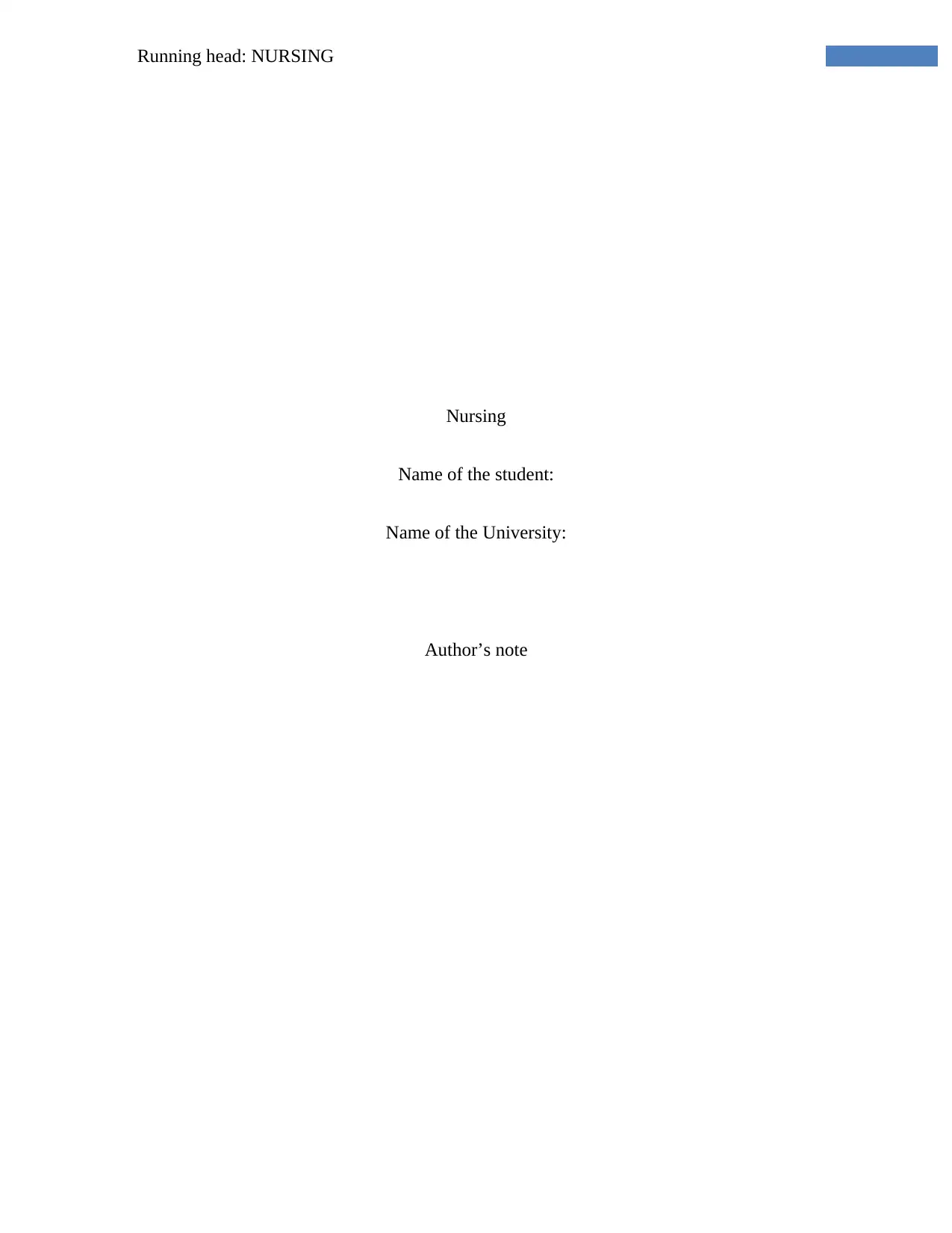
Running head: NURSING
Nursing
Name of the student:
Name of the University:
Author’s note
Nursing
Name of the student:
Name of the University:
Author’s note
Paraphrase This Document
Need a fresh take? Get an instant paraphrase of this document with our AI Paraphraser
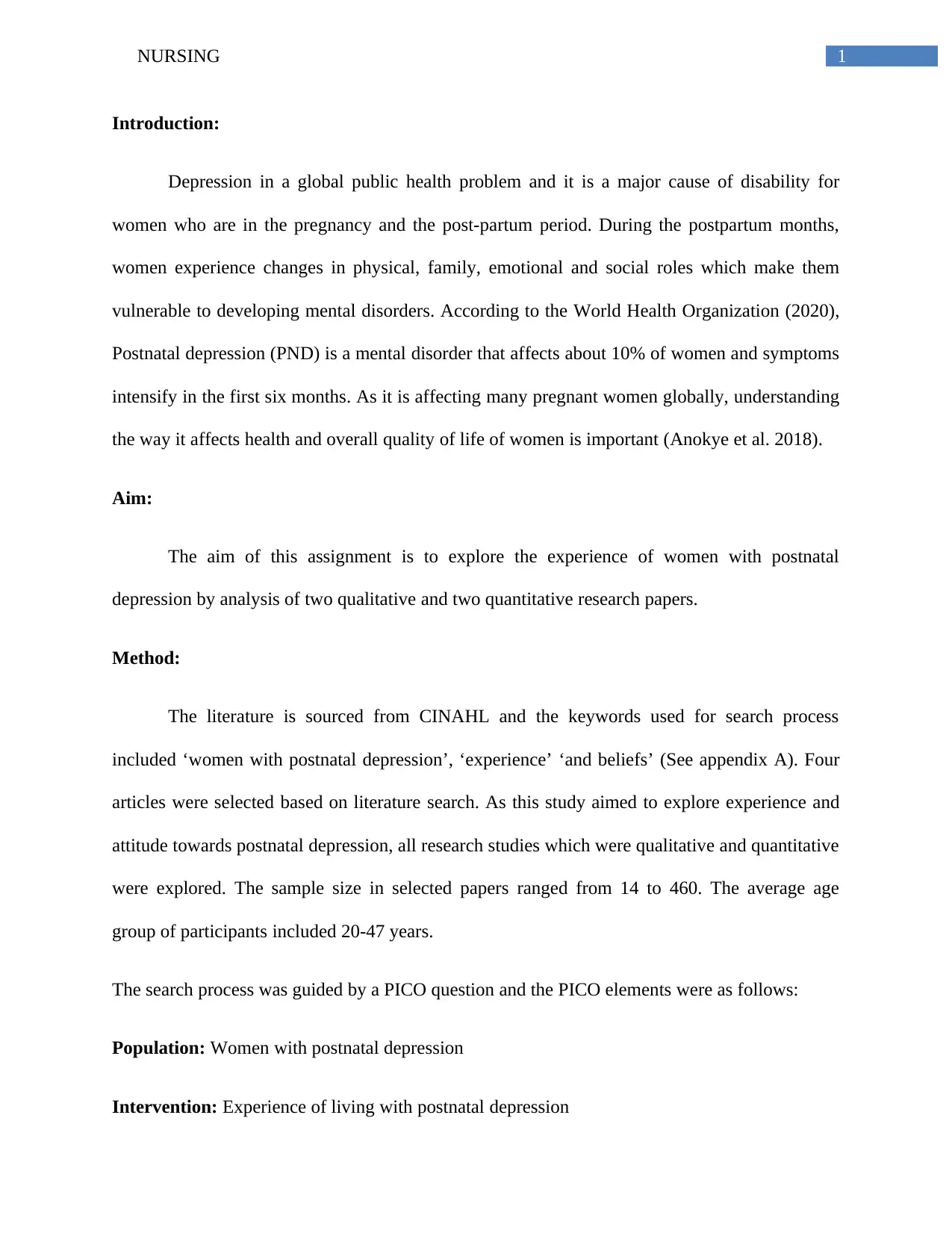
1NURSING
Introduction:
Depression in a global public health problem and it is a major cause of disability for
women who are in the pregnancy and the post-partum period. During the postpartum months,
women experience changes in physical, family, emotional and social roles which make them
vulnerable to developing mental disorders. According to the World Health Organization (2020),
Postnatal depression (PND) is a mental disorder that affects about 10% of women and symptoms
intensify in the first six months. As it is affecting many pregnant women globally, understanding
the way it affects health and overall quality of life of women is important (Anokye et al. 2018).
Aim:
The aim of this assignment is to explore the experience of women with postnatal
depression by analysis of two qualitative and two quantitative research papers.
Method:
The literature is sourced from CINAHL and the keywords used for search process
included ‘women with postnatal depression’, ‘experience’ ‘and beliefs’ (See appendix A). Four
articles were selected based on literature search. As this study aimed to explore experience and
attitude towards postnatal depression, all research studies which were qualitative and quantitative
were explored. The sample size in selected papers ranged from 14 to 460. The average age
group of participants included 20-47 years.
The search process was guided by a PICO question and the PICO elements were as follows:
Population: Women with postnatal depression
Intervention: Experience of living with postnatal depression
Introduction:
Depression in a global public health problem and it is a major cause of disability for
women who are in the pregnancy and the post-partum period. During the postpartum months,
women experience changes in physical, family, emotional and social roles which make them
vulnerable to developing mental disorders. According to the World Health Organization (2020),
Postnatal depression (PND) is a mental disorder that affects about 10% of women and symptoms
intensify in the first six months. As it is affecting many pregnant women globally, understanding
the way it affects health and overall quality of life of women is important (Anokye et al. 2018).
Aim:
The aim of this assignment is to explore the experience of women with postnatal
depression by analysis of two qualitative and two quantitative research papers.
Method:
The literature is sourced from CINAHL and the keywords used for search process
included ‘women with postnatal depression’, ‘experience’ ‘and beliefs’ (See appendix A). Four
articles were selected based on literature search. As this study aimed to explore experience and
attitude towards postnatal depression, all research studies which were qualitative and quantitative
were explored. The sample size in selected papers ranged from 14 to 460. The average age
group of participants included 20-47 years.
The search process was guided by a PICO question and the PICO elements were as follows:
Population: Women with postnatal depression
Intervention: Experience of living with postnatal depression
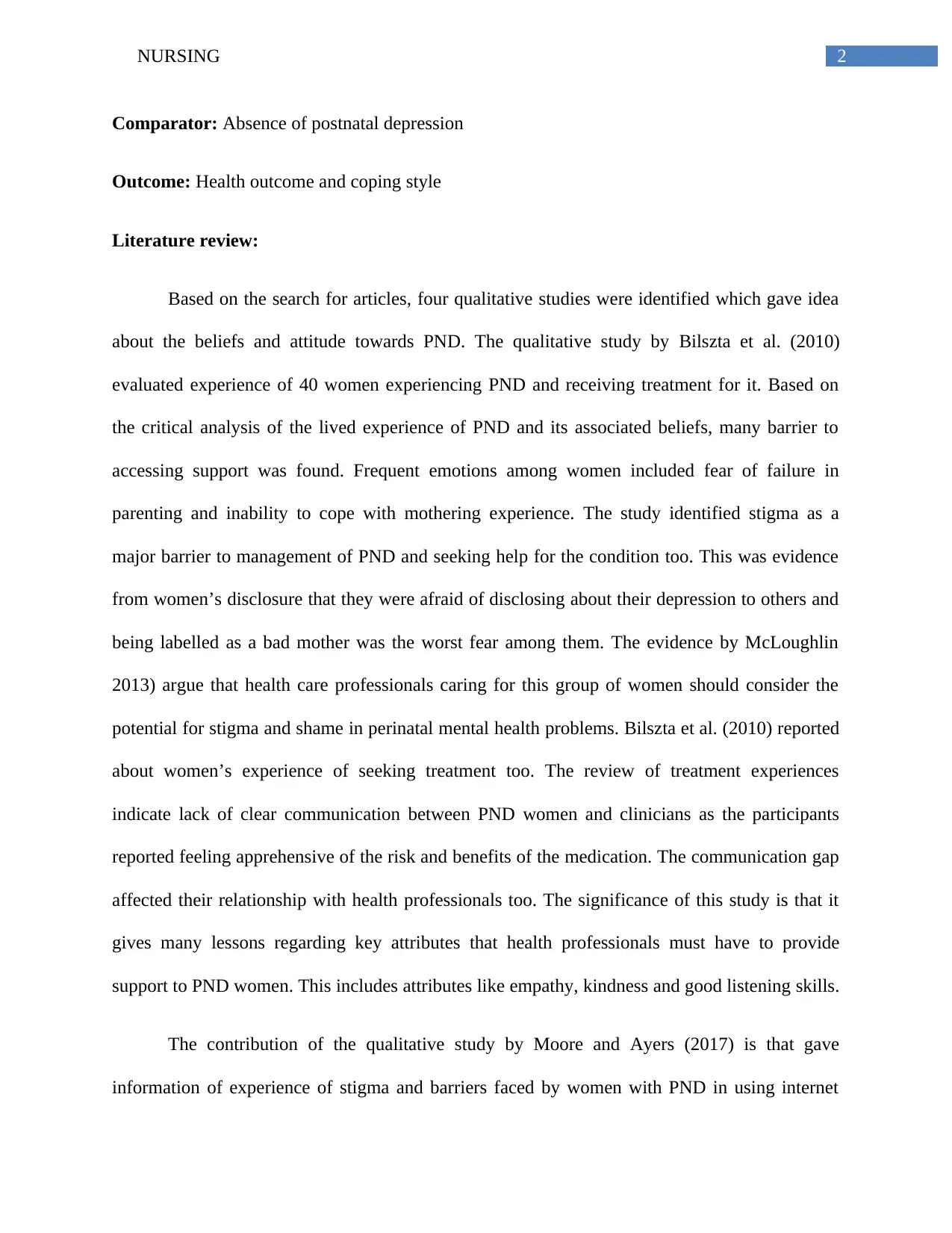
2NURSING
Comparator: Absence of postnatal depression
Outcome: Health outcome and coping style
Literature review:
Based on the search for articles, four qualitative studies were identified which gave idea
about the beliefs and attitude towards PND. The qualitative study by Bilszta et al. (2010)
evaluated experience of 40 women experiencing PND and receiving treatment for it. Based on
the critical analysis of the lived experience of PND and its associated beliefs, many barrier to
accessing support was found. Frequent emotions among women included fear of failure in
parenting and inability to cope with mothering experience. The study identified stigma as a
major barrier to management of PND and seeking help for the condition too. This was evidence
from women’s disclosure that they were afraid of disclosing about their depression to others and
being labelled as a bad mother was the worst fear among them. The evidence by McLoughlin
2013) argue that health care professionals caring for this group of women should consider the
potential for stigma and shame in perinatal mental health problems. Bilszta et al. (2010) reported
about women’s experience of seeking treatment too. The review of treatment experiences
indicate lack of clear communication between PND women and clinicians as the participants
reported feeling apprehensive of the risk and benefits of the medication. The communication gap
affected their relationship with health professionals too. The significance of this study is that it
gives many lessons regarding key attributes that health professionals must have to provide
support to PND women. This includes attributes like empathy, kindness and good listening skills.
The contribution of the qualitative study by Moore and Ayers (2017) is that gave
information of experience of stigma and barriers faced by women with PND in using internet
Comparator: Absence of postnatal depression
Outcome: Health outcome and coping style
Literature review:
Based on the search for articles, four qualitative studies were identified which gave idea
about the beliefs and attitude towards PND. The qualitative study by Bilszta et al. (2010)
evaluated experience of 40 women experiencing PND and receiving treatment for it. Based on
the critical analysis of the lived experience of PND and its associated beliefs, many barrier to
accessing support was found. Frequent emotions among women included fear of failure in
parenting and inability to cope with mothering experience. The study identified stigma as a
major barrier to management of PND and seeking help for the condition too. This was evidence
from women’s disclosure that they were afraid of disclosing about their depression to others and
being labelled as a bad mother was the worst fear among them. The evidence by McLoughlin
2013) argue that health care professionals caring for this group of women should consider the
potential for stigma and shame in perinatal mental health problems. Bilszta et al. (2010) reported
about women’s experience of seeking treatment too. The review of treatment experiences
indicate lack of clear communication between PND women and clinicians as the participants
reported feeling apprehensive of the risk and benefits of the medication. The communication gap
affected their relationship with health professionals too. The significance of this study is that it
gives many lessons regarding key attributes that health professionals must have to provide
support to PND women. This includes attributes like empathy, kindness and good listening skills.
The contribution of the qualitative study by Moore and Ayers (2017) is that gave
information of experience of stigma and barriers faced by women with PND in using internet
⊘ This is a preview!⊘
Do you want full access?
Subscribe today to unlock all pages.

Trusted by 1+ million students worldwide
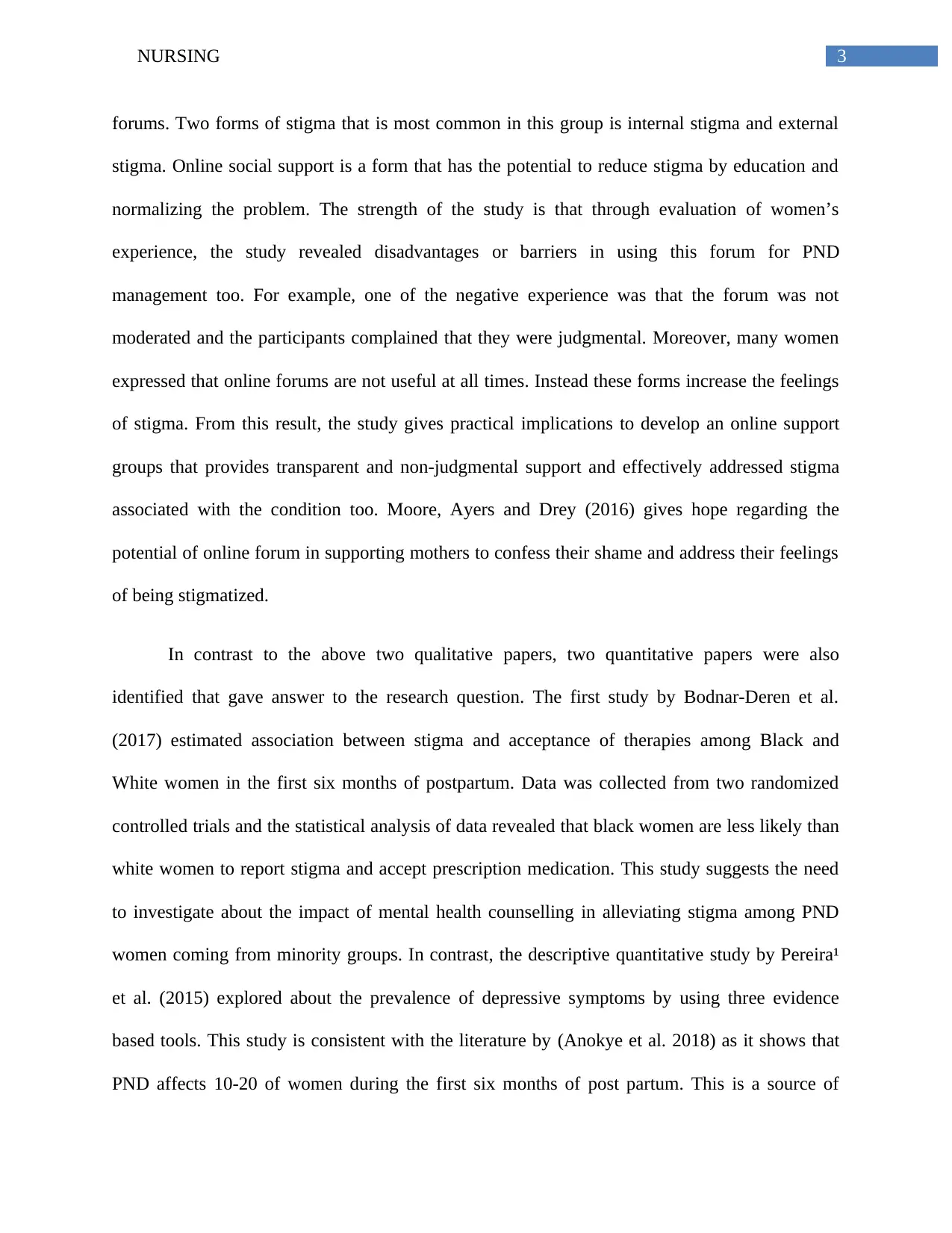
3NURSING
forums. Two forms of stigma that is most common in this group is internal stigma and external
stigma. Online social support is a form that has the potential to reduce stigma by education and
normalizing the problem. The strength of the study is that through evaluation of women’s
experience, the study revealed disadvantages or barriers in using this forum for PND
management too. For example, one of the negative experience was that the forum was not
moderated and the participants complained that they were judgmental. Moreover, many women
expressed that online forums are not useful at all times. Instead these forms increase the feelings
of stigma. From this result, the study gives practical implications to develop an online support
groups that provides transparent and non-judgmental support and effectively addressed stigma
associated with the condition too. Moore, Ayers and Drey (2016) gives hope regarding the
potential of online forum in supporting mothers to confess their shame and address their feelings
of being stigmatized.
In contrast to the above two qualitative papers, two quantitative papers were also
identified that gave answer to the research question. The first study by Bodnar-Deren et al.
(2017) estimated association between stigma and acceptance of therapies among Black and
White women in the first six months of postpartum. Data was collected from two randomized
controlled trials and the statistical analysis of data revealed that black women are less likely than
white women to report stigma and accept prescription medication. This study suggests the need
to investigate about the impact of mental health counselling in alleviating stigma among PND
women coming from minority groups. In contrast, the descriptive quantitative study by Pereira¹
et al. (2015) explored about the prevalence of depressive symptoms by using three evidence
based tools. This study is consistent with the literature by (Anokye et al. 2018) as it shows that
PND affects 10-20 of women during the first six months of post partum. This is a source of
forums. Two forms of stigma that is most common in this group is internal stigma and external
stigma. Online social support is a form that has the potential to reduce stigma by education and
normalizing the problem. The strength of the study is that through evaluation of women’s
experience, the study revealed disadvantages or barriers in using this forum for PND
management too. For example, one of the negative experience was that the forum was not
moderated and the participants complained that they were judgmental. Moreover, many women
expressed that online forums are not useful at all times. Instead these forms increase the feelings
of stigma. From this result, the study gives practical implications to develop an online support
groups that provides transparent and non-judgmental support and effectively addressed stigma
associated with the condition too. Moore, Ayers and Drey (2016) gives hope regarding the
potential of online forum in supporting mothers to confess their shame and address their feelings
of being stigmatized.
In contrast to the above two qualitative papers, two quantitative papers were also
identified that gave answer to the research question. The first study by Bodnar-Deren et al.
(2017) estimated association between stigma and acceptance of therapies among Black and
White women in the first six months of postpartum. Data was collected from two randomized
controlled trials and the statistical analysis of data revealed that black women are less likely than
white women to report stigma and accept prescription medication. This study suggests the need
to investigate about the impact of mental health counselling in alleviating stigma among PND
women coming from minority groups. In contrast, the descriptive quantitative study by Pereira¹
et al. (2015) explored about the prevalence of depressive symptoms by using three evidence
based tools. This study is consistent with the literature by (Anokye et al. 2018) as it shows that
PND affects 10-20 of women during the first six months of post partum. This is a source of
Paraphrase This Document
Need a fresh take? Get an instant paraphrase of this document with our AI Paraphraser
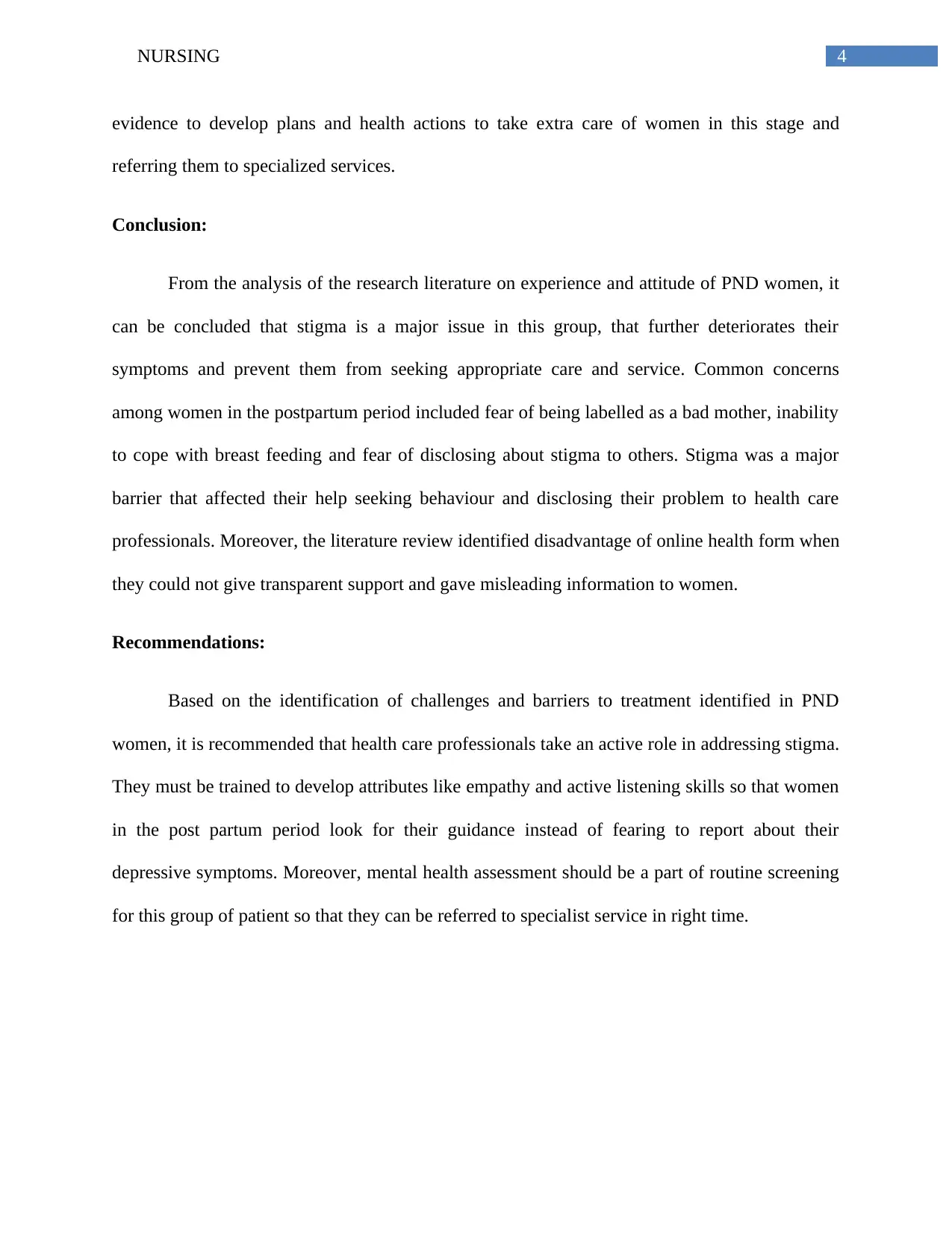
4NURSING
evidence to develop plans and health actions to take extra care of women in this stage and
referring them to specialized services.
Conclusion:
From the analysis of the research literature on experience and attitude of PND women, it
can be concluded that stigma is a major issue in this group, that further deteriorates their
symptoms and prevent them from seeking appropriate care and service. Common concerns
among women in the postpartum period included fear of being labelled as a bad mother, inability
to cope with breast feeding and fear of disclosing about stigma to others. Stigma was a major
barrier that affected their help seeking behaviour and disclosing their problem to health care
professionals. Moreover, the literature review identified disadvantage of online health form when
they could not give transparent support and gave misleading information to women.
Recommendations:
Based on the identification of challenges and barriers to treatment identified in PND
women, it is recommended that health care professionals take an active role in addressing stigma.
They must be trained to develop attributes like empathy and active listening skills so that women
in the post partum period look for their guidance instead of fearing to report about their
depressive symptoms. Moreover, mental health assessment should be a part of routine screening
for this group of patient so that they can be referred to specialist service in right time.
evidence to develop plans and health actions to take extra care of women in this stage and
referring them to specialized services.
Conclusion:
From the analysis of the research literature on experience and attitude of PND women, it
can be concluded that stigma is a major issue in this group, that further deteriorates their
symptoms and prevent them from seeking appropriate care and service. Common concerns
among women in the postpartum period included fear of being labelled as a bad mother, inability
to cope with breast feeding and fear of disclosing about stigma to others. Stigma was a major
barrier that affected their help seeking behaviour and disclosing their problem to health care
professionals. Moreover, the literature review identified disadvantage of online health form when
they could not give transparent support and gave misleading information to women.
Recommendations:
Based on the identification of challenges and barriers to treatment identified in PND
women, it is recommended that health care professionals take an active role in addressing stigma.
They must be trained to develop attributes like empathy and active listening skills so that women
in the post partum period look for their guidance instead of fearing to report about their
depressive symptoms. Moreover, mental health assessment should be a part of routine screening
for this group of patient so that they can be referred to specialist service in right time.
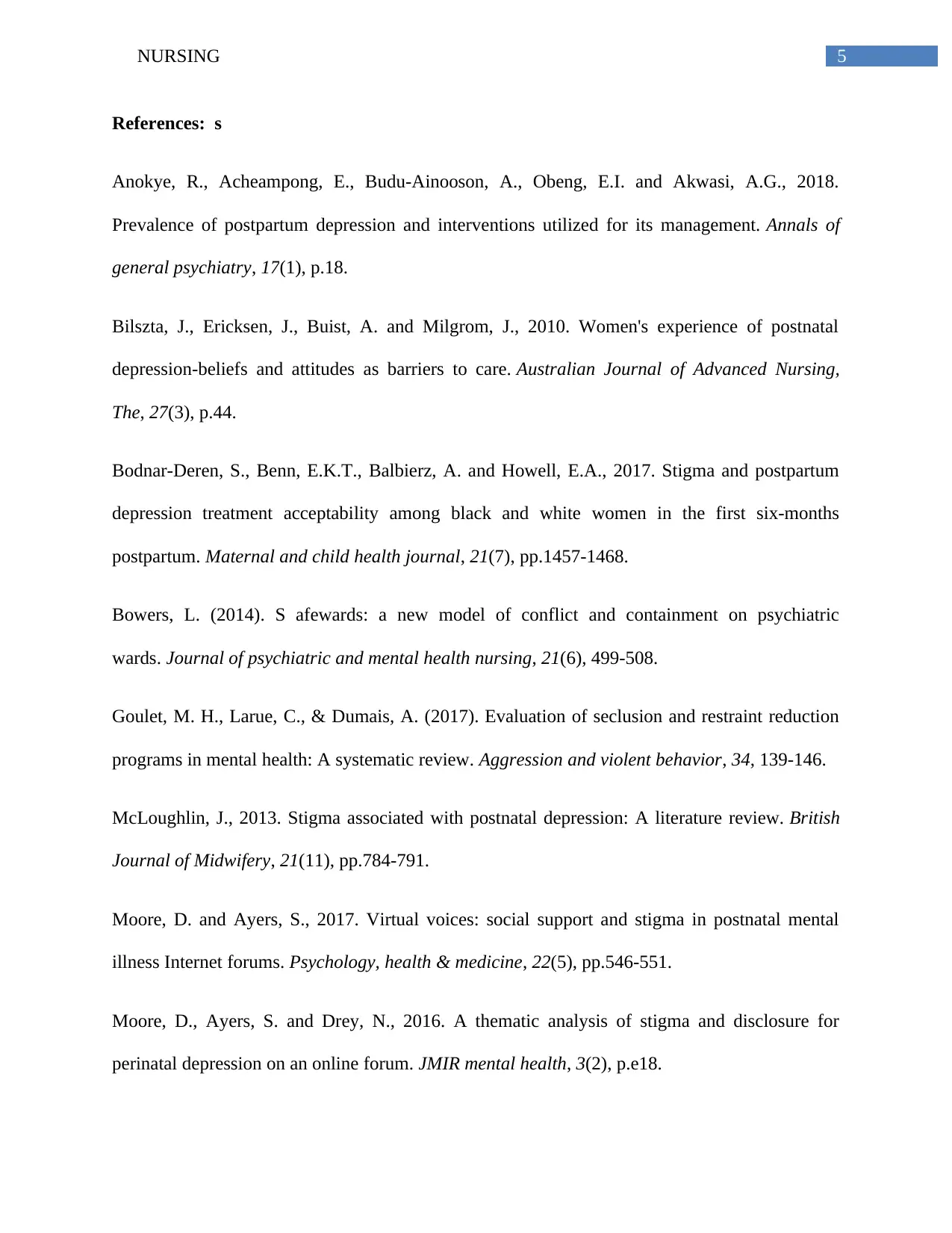
5NURSING
References: s
Anokye, R., Acheampong, E., Budu-Ainooson, A., Obeng, E.I. and Akwasi, A.G., 2018.
Prevalence of postpartum depression and interventions utilized for its management. Annals of
general psychiatry, 17(1), p.18.
Bilszta, J., Ericksen, J., Buist, A. and Milgrom, J., 2010. Women's experience of postnatal
depression-beliefs and attitudes as barriers to care. Australian Journal of Advanced Nursing,
The, 27(3), p.44.
Bodnar-Deren, S., Benn, E.K.T., Balbierz, A. and Howell, E.A., 2017. Stigma and postpartum
depression treatment acceptability among black and white women in the first six-months
postpartum. Maternal and child health journal, 21(7), pp.1457-1468.
Bowers, L. (2014). S afewards: a new model of conflict and containment on psychiatric
wards. Journal of psychiatric and mental health nursing, 21(6), 499-508.
Goulet, M. H., Larue, C., & Dumais, A. (2017). Evaluation of seclusion and restraint reduction
programs in mental health: A systematic review. Aggression and violent behavior, 34, 139-146.
McLoughlin, J., 2013. Stigma associated with postnatal depression: A literature review. British
Journal of Midwifery, 21(11), pp.784-791.
Moore, D. and Ayers, S., 2017. Virtual voices: social support and stigma in postnatal mental
illness Internet forums. Psychology, health & medicine, 22(5), pp.546-551.
Moore, D., Ayers, S. and Drey, N., 2016. A thematic analysis of stigma and disclosure for
perinatal depression on an online forum. JMIR mental health, 3(2), p.e18.
References: s
Anokye, R., Acheampong, E., Budu-Ainooson, A., Obeng, E.I. and Akwasi, A.G., 2018.
Prevalence of postpartum depression and interventions utilized for its management. Annals of
general psychiatry, 17(1), p.18.
Bilszta, J., Ericksen, J., Buist, A. and Milgrom, J., 2010. Women's experience of postnatal
depression-beliefs and attitudes as barriers to care. Australian Journal of Advanced Nursing,
The, 27(3), p.44.
Bodnar-Deren, S., Benn, E.K.T., Balbierz, A. and Howell, E.A., 2017. Stigma and postpartum
depression treatment acceptability among black and white women in the first six-months
postpartum. Maternal and child health journal, 21(7), pp.1457-1468.
Bowers, L. (2014). S afewards: a new model of conflict and containment on psychiatric
wards. Journal of psychiatric and mental health nursing, 21(6), 499-508.
Goulet, M. H., Larue, C., & Dumais, A. (2017). Evaluation of seclusion and restraint reduction
programs in mental health: A systematic review. Aggression and violent behavior, 34, 139-146.
McLoughlin, J., 2013. Stigma associated with postnatal depression: A literature review. British
Journal of Midwifery, 21(11), pp.784-791.
Moore, D. and Ayers, S., 2017. Virtual voices: social support and stigma in postnatal mental
illness Internet forums. Psychology, health & medicine, 22(5), pp.546-551.
Moore, D., Ayers, S. and Drey, N., 2016. A thematic analysis of stigma and disclosure for
perinatal depression on an online forum. JMIR mental health, 3(2), p.e18.
⊘ This is a preview!⊘
Do you want full access?
Subscribe today to unlock all pages.

Trusted by 1+ million students worldwide
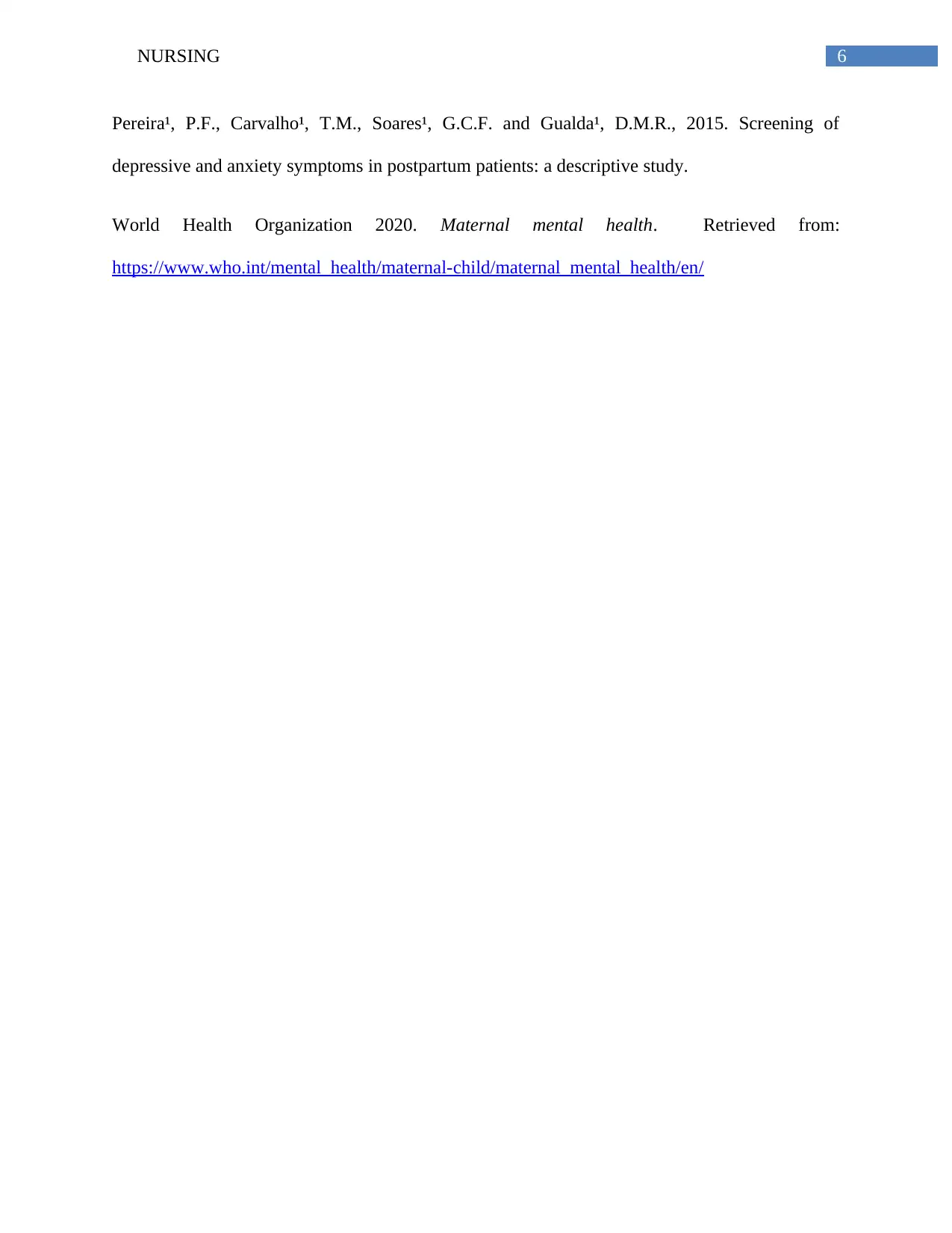
6NURSING
Pereira¹, P.F., Carvalho¹, T.M., Soares¹, G.C.F. and Gualda¹, D.M.R., 2015. Screening of
depressive and anxiety symptoms in postpartum patients: a descriptive study.
World Health Organization 2020. Maternal mental health. Retrieved from:
https://www.who.int/mental_health/maternal-child/maternal_mental_health/en/
Pereira¹, P.F., Carvalho¹, T.M., Soares¹, G.C.F. and Gualda¹, D.M.R., 2015. Screening of
depressive and anxiety symptoms in postpartum patients: a descriptive study.
World Health Organization 2020. Maternal mental health. Retrieved from:
https://www.who.int/mental_health/maternal-child/maternal_mental_health/en/
Paraphrase This Document
Need a fresh take? Get an instant paraphrase of this document with our AI Paraphraser
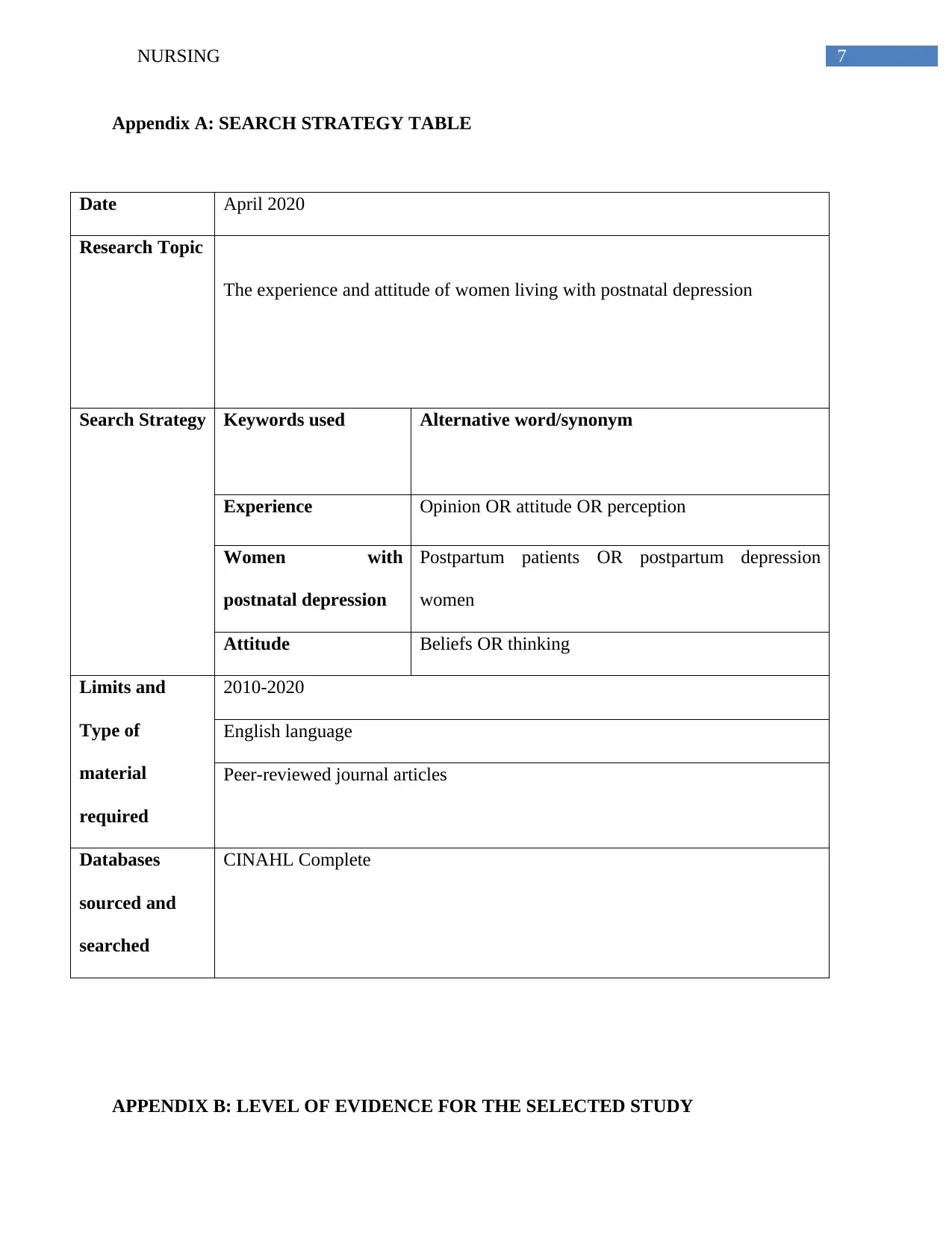
7NURSING
Appendix A: SEARCH STRATEGY TABLE
APPENDIX B: LEVEL OF EVIDENCE FOR THE SELECTED STUDY
Date April 2020
Research Topic
The experience and attitude of women living with postnatal depression
Search Strategy Keywords used Alternative word/synonym
Experience Opinion OR attitude OR perception
Women with
postnatal depression
Postpartum patients OR postpartum depression
women
Attitude Beliefs OR thinking
Limits and
Type of
material
required
2010-2020
English language
Peer-reviewed journal articles
Databases
sourced and
searched
CINAHL Complete
Appendix A: SEARCH STRATEGY TABLE
APPENDIX B: LEVEL OF EVIDENCE FOR THE SELECTED STUDY
Date April 2020
Research Topic
The experience and attitude of women living with postnatal depression
Search Strategy Keywords used Alternative word/synonym
Experience Opinion OR attitude OR perception
Women with
postnatal depression
Postpartum patients OR postpartum depression
women
Attitude Beliefs OR thinking
Limits and
Type of
material
required
2010-2020
English language
Peer-reviewed journal articles
Databases
sourced and
searched
CINAHL Complete
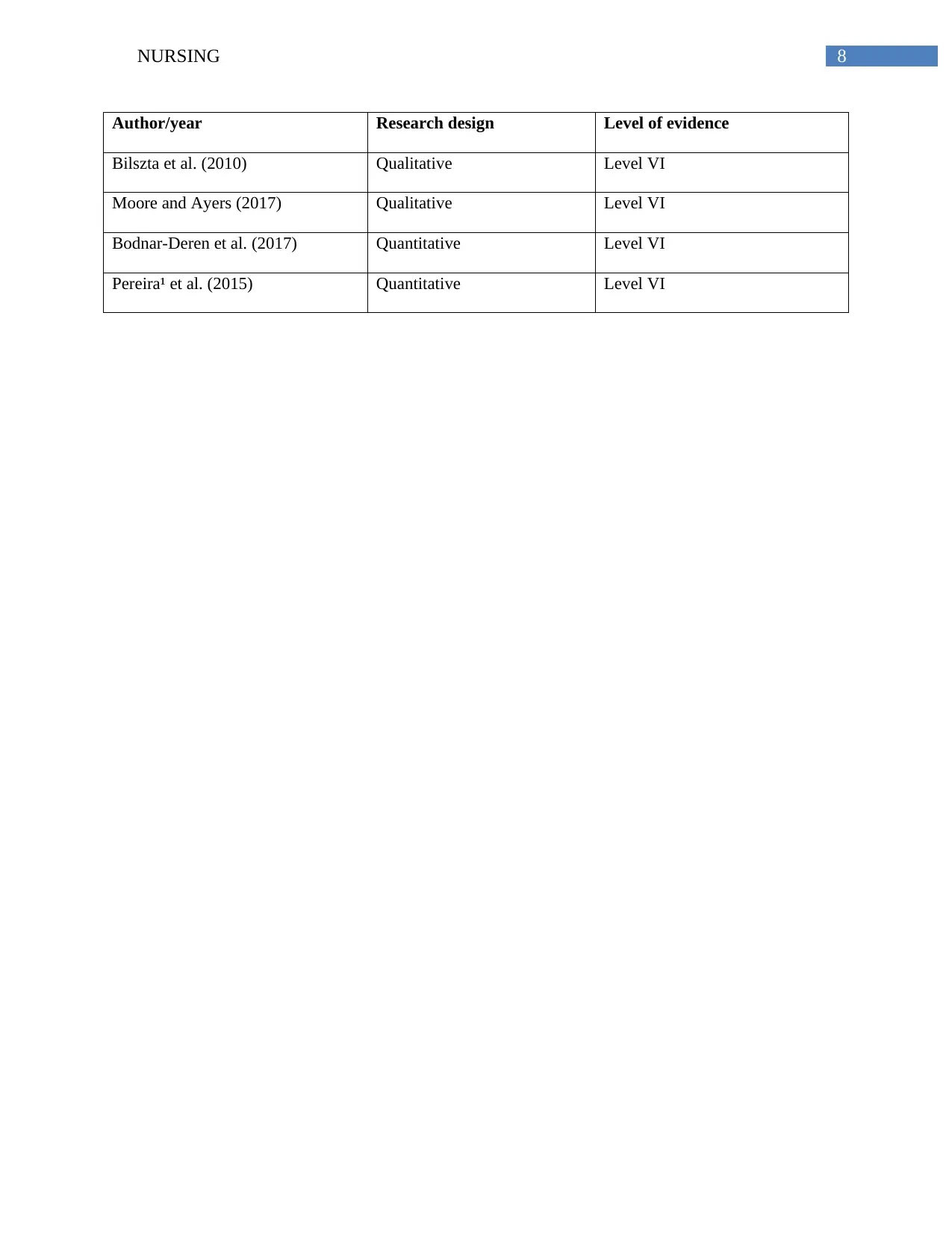
8NURSING
Author/year Research design Level of evidence
Bilszta et al. (2010) Qualitative Level VI
Moore and Ayers (2017) Qualitative Level VI
Bodnar-Deren et al. (2017) Quantitative Level VI
Pereira¹ et al. (2015) Quantitative Level VI
Author/year Research design Level of evidence
Bilszta et al. (2010) Qualitative Level VI
Moore and Ayers (2017) Qualitative Level VI
Bodnar-Deren et al. (2017) Quantitative Level VI
Pereira¹ et al. (2015) Quantitative Level VI
⊘ This is a preview!⊘
Do you want full access?
Subscribe today to unlock all pages.

Trusted by 1+ million students worldwide
1 out of 9
Related Documents
Your All-in-One AI-Powered Toolkit for Academic Success.
+13062052269
info@desklib.com
Available 24*7 on WhatsApp / Email
![[object Object]](/_next/static/media/star-bottom.7253800d.svg)
Unlock your academic potential
Copyright © 2020–2025 A2Z Services. All Rights Reserved. Developed and managed by ZUCOL.





